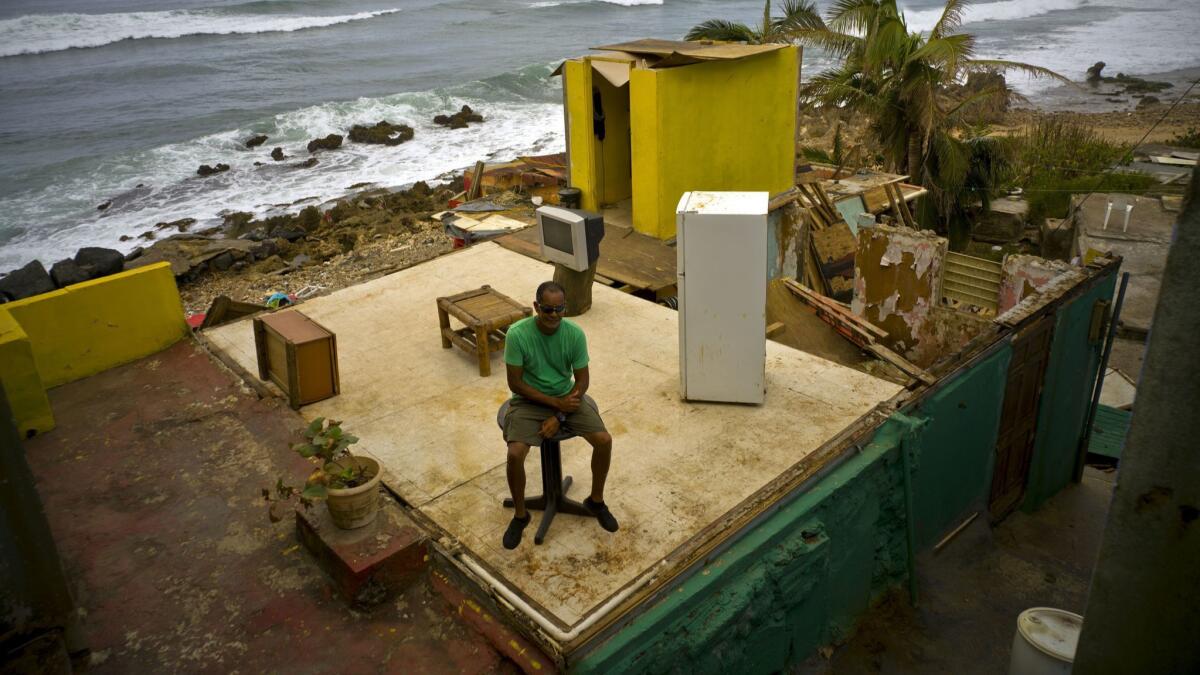Needs go unmet 6 months after Hurricane Maria hit Puerto Rico

- Share via
Reporting from San Juan, Puerto Rico — Generators are still humming. Candles are still flickering. Homes are still being repaired.
Puerto Rico was hit by Hurricane Maria exactly six months ago, and the U.S. territory is still struggling to recover from the strongest storm to hit the island in nearly a century.
“There are a lot of people with needs,” said Levid Ortiz, operating director of PR4PR, a local nonprofit that helps impoverished communities across the island. “It shouldn’t be like this. We should already be back on our feet.”
About 250 Puerto Ricans formed a line around him on a recent weekday, standing for more than two hours to receive bottles of water and boxes of food at a public basketball court in the mountain town of Corozal.
Many of those waiting were still without power, including 23-year-old Keishla Quiles, a single mother with a 4-year-old son who still buys ice every day to fill a cooler to keep milk and other goods cold amid rising temperatures.
“Since we’re a family of few resources, we have not been able to afford a generator,” she said. “It’s been hard living like this.”
Crews have restored water to 99% of clients and power to 93% of customers, but more than 100,000 of them still remain in the dark and there are frequent power outages.
Justo Gonzalez, interim director for Puerto Rico’s Electric Power Authority, said he expects the entire island to have power by May, eight months after the Category 4 storm destroyed two-thirds of the island’s power distribution system — and just as the 2018 Atlantic hurricane season is about to start.
Gonzalez also pledged to inspect dozens of wooden and cement poles still leaning haphazardly across the island. A wooden telephone pole fell on a car Sunday, killing an elderly couple returned from a town fair in the mountains of western Puerto Rico.
The storm caused an estimated $100 billion in damage, killed dozens of people and damaged or destroyed nearly 400,000 homes, according to Puerto Rico’s government.
In the six months since the hurricane, more than 135,000 people have fled to the U.S. mainland, according to a recent estimate by the Center for Puerto Rican Studies at Hunter College in New York.
More than 40% of them settled in Florida, followed by Massachusetts, Connecticut, New York and Pennsylvania, the study found.
Meanwhile, those who stayed behind say they need more help.
The AP recently found that of the $23 billion pledged for Puerto Rico, only $1.27 billion for a nutritional assistance program has been disbursed, along with more than $430 million to repair public infrastructure. The U.S. Federal Emergency Management Agency also has spent more than $6 billion from its standing emergency fund.
Tom Bossert, President Trump’s homeland security advisor, said Tuesday that Puerto Rico would soon receive an additional $10 billion for various restoration efforts.
“We’re going to redouble our efforts to work as fast as we can on their behalf,” he said of Puerto Ricans during a three-day visit to the island.
However, he said the administration of Gov. Ricardo Rossello needs to come up with a plan to build a stronger power grid and create financial accounting methods to ensure federal funds are being appropriately spent.
More to Read
Sign up for Essential California
The most important California stories and recommendations in your inbox every morning.
You may occasionally receive promotional content from the Los Angeles Times.













